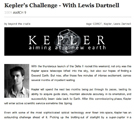Kepler’s Challenge
 With the thunderous launch of the Delta II rocket this weekend, not only was the Kepler space telescope lofted into the sky, but also our hopes of finding a Second Earth. But now, after those few minutes of intense excitement, comes several months of impatient waiting.
With the thunderous launch of the Delta II rocket this weekend, not only was the Kepler space telescope lofted into the sky, but also our hopes of finding a Second Earth. But now, after those few minutes of intense excitement, comes several months of impatient waiting.
Kepler will spend the next two months being put through its paces, testing its ability to acquire guide stars, maintain absolute accuracy in its orientation, and successfully beam data back to Earth. After this commissioning phase, Kepler will enter active scientific service sometime this Spring.
Even with some of the most sophisticated optical technology ever flown into space, Kepler has an astounding challenge ahead of it. Picking up the blotting-out of starlight by a super-Jupiter in a suicidally close orbit across the face of its sun is one thing, but detecting the ever-so-subtle wink from a terrestrial planet at 1 AU is orders of magnitude more difficult again. One analogy has it that spotting a transiting Earth is like catching a flea crawling across a searchlight from miles away. But even this doesn’t quite capture the enormity of the task. Spotting a transiting Earth is more like catching a flea crawling across a searchlight from miles away, whilst the searchlight is constantly flickering and the flea only actually obscures one percent of one percent of the light for a short time, and only passes once every year.
The French space telescope COROT, although not specifically designed for planet-hunting as Kepler has been, has proven itself capable of finding new exoplanets. But perhaps the most significant revelation from COROT is just how variable many stars can be, fluctuating with noisy activity that could potentially swamp the dimming signal from any transiting Earth.
Now, Kepler will have a wider field of view and a more sensitive photometer than COROT, and be able to fixate on the same region of sky for it’s entire three-year mission. So between the French and Americans, the balance of the odds are really tipped in favour of the Western-Atlantic to scoop the prize of the discovery of the first truly Earth-like world.
If Kepler does find any Earth-sized planets orbiting within the habitable zone of its monitored stars, it will be around a star cooler than the Sun. This is because the cooler the star, the closer-in the habitable zone, and therefore the quicker the orbit. For M-class red dwarf stars, stars roughly ten times more populous in the galaxy that sun-like stars, the habitable orbit is a few weeks to months long. So Kepler may even announce it’s first habitable Earth by this time next year. For habitable terrestrial planets around Sun-like stars (where the habitable orbit is obviously the same as for Earth – one year long), Kepler would need at least three years to confirm any discoveries.
Ultimately, however, the chances of either COROT or Kepler spotting a Second Earth are dictated by the frequency of Earth-like planets in our corner of the galaxy. Kepler might bag a whole clutch of terrestrial worlds, perhaps even tens of Earth-like planets over its three year mission, or alternatively it may not spot even a single one. This later possibility, although it will be felt with acute disapointment by the whole exoplanetary and astrobiology community, will still hold an extremely valuable scientific result. Taking into account the sensitivity of Kepler’s systems and the number of stars it is surverying, such a null result will place a firm upper-limit on the frequency of Earths. In either case, Kepler, combined with results from COROT, will provide this highly-prized magic number – the frequency of Earths in our galaxy, and therefore how many potential homes there are for extraterrestrial life.
If you want to find out more about the science behind planet-hunting, and the promise that Kepler holds for the exoplanetary community, I would strongly recommend you read ‘Crowded Universe’ by Alan Boss, an astrophysicist who has been working closely on this space mission.
Read full post on Beyond the Cradle